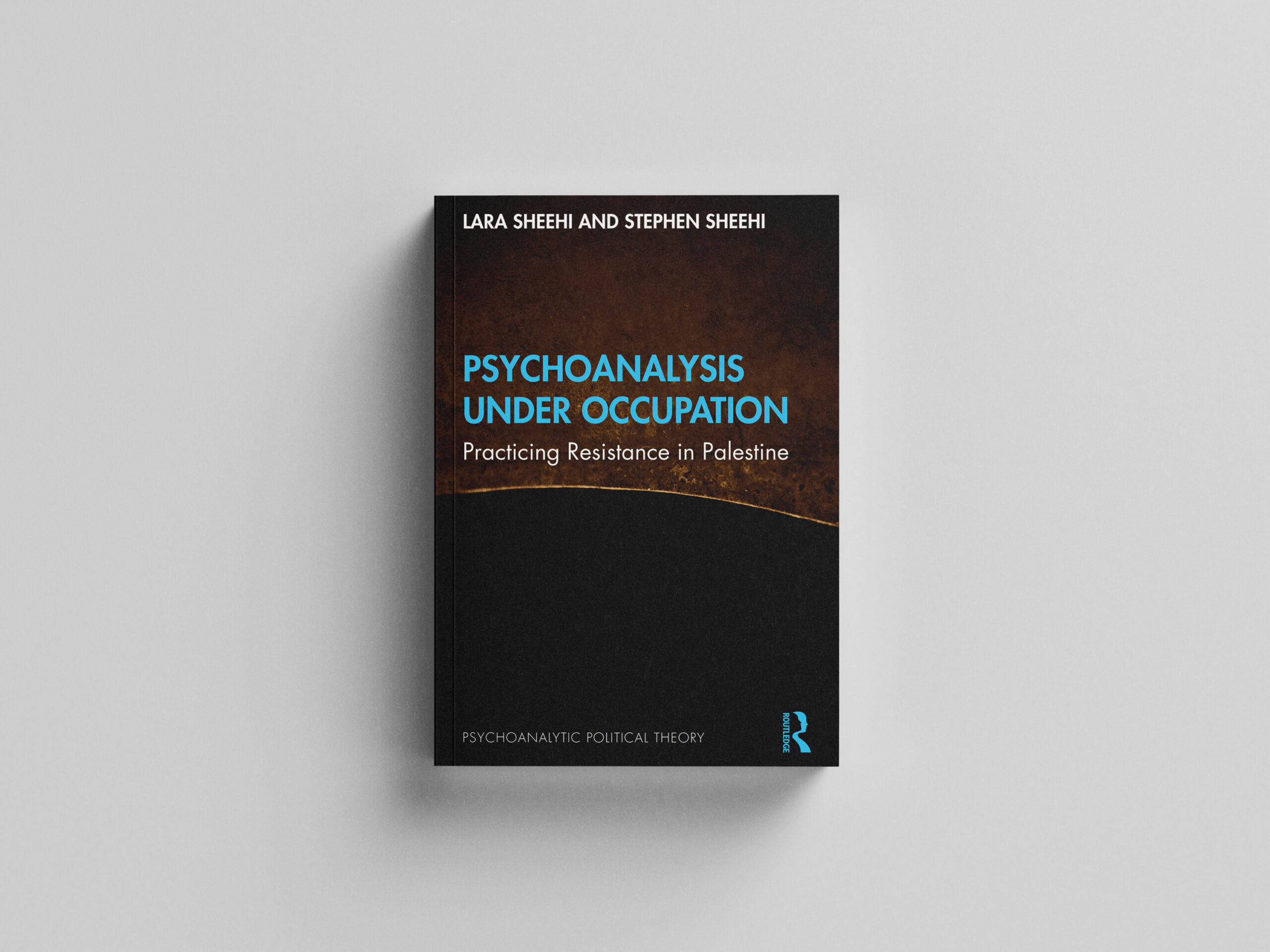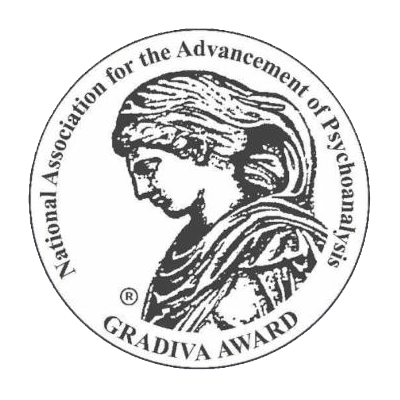BOOK REVIEW
by Richard Grose

Psychoanalysis Under Occupation: Practicing Resistance in Palestine by Lara Sheehi and Stephen Sheehi
Even a reader who agrees with the views implied in the title of Psychoanalysis Under Occupation: Practicing Resistance in Palestine may find this, as I did, to be an astonishing and revelatory book. The authors, Lara and Stephen Sheehi, a psychoanalyst and a humanities professor, respectively, of Arab Lebanese descent, introduce us to Palestinian patients and clinicians in order to bring their English-speaking readers into the lives and minds of Palestinians living under Israeli occupation. The two foci of the book are: the Occupation seen through the lens of psychoanalysis, and psychoanalysis under the conditions of the Occupation.
Their first focus, the Occupation, is to acquaint us with Palestinian patients and clinicians to make us feel the violence and humiliation that they are daily subjected to under Occupation by what the authors always term the “settler-colonial” power, that is, Israel. Let us begin by considering the case of Amjad. A father of three, in his early thirties, Amjad presents for therapy due to a sensation of a lump or a ball in his throat whenever he becomes nervous. He is treated by a Palestinian therapist, who is supervised by an Israeli supervisor. Although both therapist and supervisor ostensibly work in a psychodynamic way, the supervisor wants immediately to give the patient medication for anxiety although the therapist wants to hear what the patient has to say. When the patient refuses medication, the treatment continues with Amjad turning sessions into obsessive recitations of his anxieties. As the treatment continues, Amjad begins talking about specific moments in which he has felt suffocated, many of which relate to his experiences with Israeli military and police. At this point, the supervisor indicates that it is time to terminate treatment. When the therapist relays this to the patient, Amjad explodes in anger at the therapist’s proposal to abandon their work. Deciding not to terminate a treatment that was deepening, the therapist then works without supervision. Soon after this, Amjad says that the ball in his throat is really his hatred of himself. This leads to his relating a story that occurred two years prior of his driving his then-seven-year-old daughter, who was in an exuberant, happy mood, to a birthday party. At a checkpoint, there is a delay because of protesters throwing stones at the Occupation troops. When Amjad asks a soldier if his daughter can use the bathroom, the soldier, pointing his gun at him, says, “Get back in your car and tell your daughter to piss herself in the car.” Hugging his devastated daughter, Amjad drives home and notices for the first time a ball forming in his throat.
I relate this case history because it reflects so much of what this book is about. We see Amjad’s and his daughter’s attempt to lead normal lives being destroyed in a moment of reflexive Israeli cruelty. We see the Israeli supervisor viewing the Palestinian patient through the filter of her life as an Israeli, which prevents her from being curious about the mind of the patient and prompts her to terminate the treatment as soon as the Occupation comes up in the material. We see a Palestinian therapist, following the principles of psychoanalytic listening to the point where her patient can reveal to her the traumatic moment when his symptom appeared. And we see how in Palestine the Occupation comes into the consulting room.
On the subject of the Occupation, by the end of the book, we have read discussions of “unchilding as a system,” or the systematic destruction of “the joy and playfulness of a child [which] stands in opposition to the realities of settler colonialism as a violent structure that assiduously works to make itself present and felt at every moment (p.54).” In other words, in “an apartheid system of institutional psychological violence,” the treatment of Amjad’s daughter, “to strip her of humanity and dignity, to paralyze her, to humiliate her (p.55)” is indeed the point of the system, together with destroying her father’s power to protect her. A system designed to destroy the psyches of the occupied people is termed here a “necropower,” where death, physical and psychological, is not “an unfortunate by-product of a political ‘conflict’ or inevitable consequence of draconian but necessary security measures (p.55)” but rather the very point of the Occupation.
In conditions of the Occupation, this book argues, where the entire force of the state aims to destroy the basic psychological structures of life (represented by this father and daughter), suicide can take on a very different meaning than it does in other circumstances. Suicide in Palestine can be the refusal to participate in the slow death that the state makes of life, and it is often aimed at asserting the very values that the settler-colonial power strives to eliminate, namely, the possibility that individual Palestinians can act on their own behalf, protesting what the authors term the necropower that holds all Palestinians in its grip, and asserting the possibility of a community of values that can exist only in violent protest against the violence of this necropower. Suicide statistics are cited in the book as evidence of social breakdown under the Occupation, but suicide is also seen as potentially expressive and positive in affirming social values that are under systematic attack. “These acts of self-realization are in response to a sustained hegemonic structure of settler-colonial violence engineered to atomize individuals, attempting to strip them of their communities, their identities, and their internal ego coherence. That is, their actions are a reaction to sociopathic settler-colonial structures (p. 92).” Seeing suicide as affirmation within a reality systematically designed to destroy the soul is one challenge this book presents to classical psychoanalysis, which, it is important to remember, was born in comfortable bourgeois circumstances.
The second focus of the book is psychoanalysis under the conditions of the Occupation. The authors make two points, both full of meaning for psychoanalytically informed readers: they show psychoanalysis in Palestine to be placed in the service of both oppression and liberation.
First, oppression. They show that psychoanalytic thinking is used by the Israeli settler-colonial power as ideological support for their aims. One use is psychoanalytic diagnosis to pathologize resistance. A Palestinian who is experiencing anger is seen as regressing to the paranoid-schizoid position; the diagnosis here denies the reality that a Palestinian has every reason to be angry with her life as determined by Israel. One Palestinian clinician, however, put it in broader terms: “If one is compelled to name a psychological symptom, [one is] often avoiding the language of the patient […] Diagnosing is a blockage (a checkpoint) to accessing the language of the patient. Diagnosis increases alienation (p.66).”
Another such use is “dialogue.” The authors make clear that a “dialogue” between the colonizers and the colonized that presumes the parties are equals denies reality and can only normalize the colonial situation. Thus “dialogue,” which in the psychoanalytic context is viewed as a positive thing, talking/verbalizing, in the Palestinian context connotes the disavowal of the reality of the Occupation.
A further use of psychoanalytic terms to mask reality is the use of the term “neutrality.” The authors quote Martin Kemp that “psychoanalysis, predicated on the assumption of neutrality of the analyst, ‘disguises a firm support for the denied, but systemic, racialized violence that characterizes inter-community relations in Palestine/Israel (p. 116, emphasis in the original).’” The authors term this use of psychoanalysis “psychoanalytic innocence.” Finally, they show that whenever clinicians or organizations are challenged in their use of psychoanalysis as described here, the response is one of anger (p. 118).
Second, liberation. Psychoanalysis is also wielded in Palestine as an instrument of liberation, for life and against the death drive of the Israeli settler-colonial project. The authors begin with Franz Fanon, who said that “the role of the clinic and the psychiatric hospital must be an institution of disalienation (p. 183).” They discovered in Palestine a network of “autonomous clinics that serve exclusively Palestinian populations (p.183),” in other words, clinics in Palestine that aim precisely at disalienation by withdrawing from institutional ties to the Israeli clinical system.
The authors write, “The social and professional relations between clinics and clinicians not only produce knowledge for the maintenance of livability and sumud. They also produce a network of practice and care that constitute an autonomous national space for Palestinian livability, affirmation, and indeed reality checking (p. 184).” An autonomous national space. The authors are clear about the absence of any politics in the region. Any real politics would have to be based on shared understandings of the nonviolent ways power is distributed. Palestine lives without politics, that is, with violence. But the Palestinian clinical world, under the circumstances of the radical elimination of any real politics, has created a psychoanalytically based space that shows as clearly as perhaps any psychoanalytic entity since “Freud’s Free Clinics” the liberatory implications in psychoanalysis.
It should also be said, as it is several times in the book, that although Palestinian clinicians are open to exploring the “realities of the Israeli settler colony” with their Palestinian patients, they do not reduce all complaints to that. Returning to the subject of suicide, they indicate that suicide can be either a “political act of freedom” or “a neoliberal outcome of individualist narcissism and self-interest (p. 200).” In holding both interpretations open—social/political protest and individual psychopathology—they are, I would argue, practicing a form of neutrality, but they seemingly can hardly say so, given the appropriation of that word by psychoanalytic innocence.
Finally, a personal note. Although my support for the Palestinian cause in the current situation was complete and entire when I picked up this book, reading the descriptions of the suffering of Palestinian patients both from social as well as intrapsychic sources and the many compelling stories of Palestinian clinicians who do their best for their patients under extremely difficult circumstances, I was struck by my own reaction. Indeed, I became aware that I had unconsciously introjected some of the Israeli settler-colonial mind-set when I noted my surprise in reading about the inner worlds of Palestinian patients and clinicians. I learned from this book that I, too, had unconsciously adopted a shallow view of Palestinians either as victims or fighters but not as people with inner lives. For this alone I am very grateful to the authors.
- Richard Grose, PhD, is a psychoanalyst who is a member of ROOM’s editorial board and book review editor for ROOM. He is interested in how culture and psychoanalysis can illuminate each other. He has a private practice in psychotherapy and psychoanalysis in Manhattan.
-
Email: rgrose93@gmail.com
ROOM is entirely dependent upon reader support. Please consider helping ROOM today with a tax-deductible donation. Any amount is deeply appreciated. |




